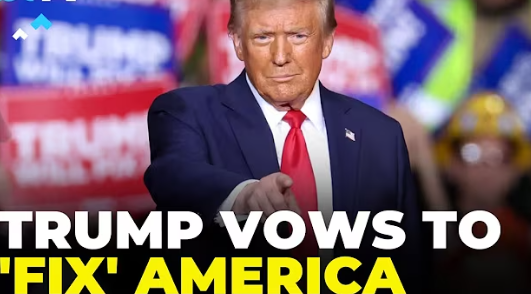Introduction: A Shocking Move with Global Consequences In a move that has sent shockwaves through the global economy, former President Donald Trump has confirmed that the United States will impose 25% tariffs on all imports from Canada and Mexico. This aggressive trade policy has led to a sharp decline in Wall Street, with major stock indices plummeting. The decision, which Trump described as “necessary for national security and economic fairness,” has sparked outrage from business leaders, economists, and international allies.

Stock Market Reaction: Wall Street in Freefall
The financial markets reacted swiftly and negatively to the announcement.
- The Dow Jones Industrial Average plunged 800 points within hours of the news breaking, marking one of its worst single-day losses in recent months.
- The S&P 500 fell by 2.5%, with trade-sensitive stocks suffering the most.
- The Nasdaq Composite dropped by 3%, with tech companies particularly affected due to their reliance on cross-border supply chains.
Investors are deeply concerned that these tariff will lead to increased costs for businesses and consumers, heightening the risk of a recession. Market analysts warn that prolonged trade tensions could lead to further economic instability, job losses, and capital flight from the United States.
Trump’s Justification: National Security and Trade Deficits
According to Trump, the tariffs are necessary to address what he calls “unfair trade practices” by Canada and Mexico. His administration argues that:
- Protecting American Jobs – Tariffs will encourage domestic production and reduce reliance on foreign manufacturing.
- Reducing the Trade Deficit – The U.S. runs a significant trade deficit with Canada and Mexico, and tariffs are seen as a way to balance the scales.
- Enhancing National Security – Trump claims that weaker border policies and economic vulnerabilities pose a security risk to the United States.

However, critics argue that these tariffs could do more harm than good, potentially leading to inflation, supply chain disruptions, and retaliation from key trading partners.
International Reaction: Canada and Mexico Push Back
The response from Canada and Mexico has been swift and firm.
- Canadian Prime Minister Justin Trudeau condemned the tariff as “an attack on North American economic stability.” In retaliation, Canada has announced a 25% counter-tariff on a range of U.S. goods, including steel, aluminum, and agricultural products.
- Mexican President Andrés Manuel López Obrador called the tariffs “unacceptable” and signaled that Mexico would explore legal action under USMCA trade agreements.
Both nations are now considering bringing their case to the World Trade Organization (WTO), arguing that these tariff violate international trade laws.
Economic Fallout: Key Industries Hit Hard
Industries most affected by these tariff include:
- Automotive Sector – U.S. car manufacturers rely heavily on parts from Canada and Mexico. The tariff will increase vehicle production costs, leading to higher prices for consumers.
- Agriculture – American farmers who export goods to Canada and Mexico, such as soybeans and dairy, now face potential retaliatory tariffs, which could severely impact their revenue.
- Retail & Consumer Goods – Products that rely on raw materials from Canada and Mexico will see price hikes, which could dampen consumer spending.
Experts warn that if these tariff remain in place for an extended period, businesses may relocate operations outside of the U.S. to avoid rising costs, further exacerbating job losses.
Political Fallout: Bipartisan Concerns
The tariffs have ignited a fierce political debate within the U.S.:
- Republicans – Some members of Trump’s party support the move, arguing that it will force Canada and Mexico to renegotiate trade deals on more favorable terms.
- Democrats – Many have criticized the tariffs, warning that they could lead to a financial crisis and disproportionately harm American workers.
- Business Leaders & Economists – Wall Street executives and trade analysts have warned that the tariffs will slow economic growth and could trigger a recession if left unchecked.
Historical Context: Trump’s Tariff Legacy This is not the first time Trump has used tariff as a political and economic tool. During his presidency, he imposed hefty tariffs on China, leading to a prolonged trade war. While some industries benefited from protectionist policies, many suffered losses due to increased production costs and reduced export opportunities.

The tariff on Canada and Mexico mark an escalation in Trump’s protectionist approach, raising concerns about further trade conflicts with key allies.
Future Outlook: What’s Next?
The coming weeks will be crucial in determining the long-term impact of these tariff. Possible scenarios include:
- Trade Negotiations – Canada and Mexico may attempt to negotiate with the U.S. to reduce the tariff burden.
- Legal Challenges – Both nations could challenge the tariffs through international trade organizations.
- Market Recovery or Further Decline – Investors will closely monitor economic data and corporate earnings reports to gauge the broader impact of the tariffs.
For now, uncertainty reigns as businesses, policymakers, and global markets brace for the consequences of Trump’s latest economic maneuver.
Conclusion: A Risky Gamble for the U.S. Economy
Trump’s decision to impose 25% tariffs on Canada and Mexico has sent Wall Street into turmoil, sparking fears of a global economic slowdown. While the administration argues that these tariffs will protect American jobs and reduce trade deficits, critics warn of severe economic repercussions. With Canada and Mexico poised to retaliate, the coming months will be pivotal in shaping the future of North American trade relations and the global economy at large.














